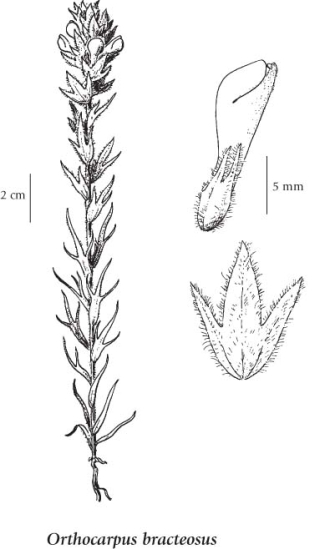Orthocarpus bracteosus Benth.
rosy owl-clover (rosy owl's-clover)
Orobanchaceae (Broom-rape family)
(Previously in Scrophulariaceae)
Introduction to Vascular Plants
rosy owl-clover (rosy owl's-clover)
Orobanchaceae (Broom-rape family)
(Previously in Scrophulariaceae)
Introduction to Vascular Plants
Species Information
General:
Annual herb; stems erect, 10-40 cm tall, slender, simple or branched above, short-hairy, usually purple-tinged.
Leaves:
Alternate, unstalked, linear to lanceolate, 1.5-3.5 cm long, green, short-spreading-hairy and often also glandular-hairy, entire below, 3-cleft above, the upper leaves passing into the wider, 3-lobed bracts of the inflorescence.
Flowers:
Inflorescence a dense, ultimately elongate, prominently bracted, densely hairy and glandular-hairy, terminal spike 3-15 cm long, the bracts uniformly green or the upper purple-tinged, glandular-soft-hairy, 10-20 mm long, differing gradually from the leaves, more or less egg-shaped, divided two-thirds of the way down into 3 (5) triangular-lanceolate lobes; corollas rose-purple, hairy, 12-20 mm long, exserted from the bracts, tubular, 2-lipped, the upper lip beaked and hooked, scarcely exceeding the lower lip, the lower lip swollen, pouched, toothless; calyces tubular, 6-10 mm long, green, glandular-hairy, unequally 4-lobed; stamens 4.
Fruits:
Capsules, ellipsoid, 5-7 mm long; seeds 8 to 15, about 3 mm long, with tight-fitting, netted, ridged coats.
Notes:
This species was formerly known from several locations in the Victoria area but has not been collected there since 1954.
Illustration

If more than one illustration is available for a species (e.g., separate illustrations were provided for two subspecies) then links to the separate images will be provided below. Note that individual subspecies or varietal illustrations are not always available.
Illustration Source: The Illustrated Flora of British Columbia
Ecology
Ecological Framework for Orthocarpus bracteosus
The table below shows the species-specific information calculated from
original data (BEC database) provided by the BC Ministry of Forests and Range.
(Updated August, 2013)
The table below shows the species-specific information calculated from
original data (BEC database) provided by the BC Ministry of Forests and Range.
(Updated August, 2013)
| Site Information |
Value / Class |
||
|
Avg |
Min |
Max |
|
| Elevation
(metres) |
845 | 815 | 888 |
| Slope
Gradient (%) |
0 | 0 | 2 |
|
Aspect (degrees) |
270 | 270 | 270 |
| Soil
Moisture Regime (SMR) [0 - very xeric; 4 - mesic; 8 - hydric] |
2 | 2 | 3 |
| Modal
Nutrient Regime
Class |
C | ||
| #
of field plots species was recorded in: |
4 | ||
| Modal
BEC Zone Class |
PP | ||
|
All BEC Zones (# of stations/zone) species was recorded in |
IDF(1), PP(3) | ||
|
Source:
Klinkenberg 2013
|
|||
Habitat and Range
Mesic meadows and fields in the lowland zone; rare, known recently only from Trial Island; S to N CA.Status Information
| Origin Status | Provincial Status | BC List (Red Blue List) | COSEWIC |
|---|---|---|---|
| Native | S1 | Red | E (May 2004) |
BC Ministry of Environment: BC Species and Ecosystems Explorer.
Synonyms
Synonyms and Alternate Names:
Orthocarpus bracteosus var. albus D.D. Keck
Similar Species
Potentially co-occurring similar species include Castilleja ambigua, C. attenuata, Triphysaria pusilla, and T. versicolor ssp. versicolor. Triphysaria species can be distinguished from Orthocarpus bracteosus by their lower corolla lip, which is strongly three-pouched, and by their anthers, which are one-celled. In Triphysaria and Castilleja, the beak-like upper corolla tips are open and the stigma is expanded, while Orthocarpus has closed tips and a dot-like stigma. The two Castilleja species and Triphysaria versicolor ssp. versicolor have white or yellow corollas in contrast to the rose-purple ones of O. bracteosus. Triphysaria pusilla has red-purple corollas, but they are much smaller (4-6 mm) than the corollas of O. bracteosus (12-20 mm). Without flowers, these taxa can be difficult to distinguish.
Source: British Columbia Conservation Data Centre |